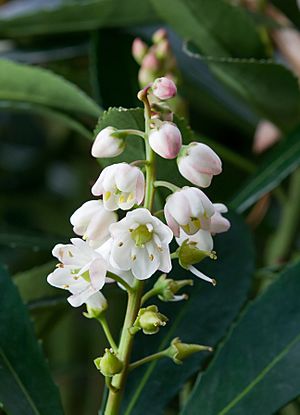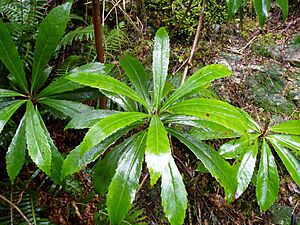Native laurel facts for kids
Quick facts for kids Tasmanian laurel |
|
|---|---|
 |
|
| Scientific classification | |
| Genus: |
Anopterus
|
| Species: |
glandulosus
|
The Tasmanian laurel, also called native laurel, is a special kind of shrub or small tree. Its scientific name is Anopterus glandulosus. It belongs to a plant family called Escalloniaceae. This plant only grows in the southern and southwestern parts of Tasmania, an island state of Australia. You can find it in wet forests, like temperate rainforests and wet sclerophyll forests, from the coast all the way up to mountains below 1,200 meters (about 3,900 feet).
Contents
What's in a Name?
The name Anopterus comes from ancient Greek words. Ano means 'upwards' and pteron means 'wing'. This name describes its seeds, which have a wing-like shape that helps them fly upwards. The second part of its name, glandulosus, points to the tiny, gland-like tips found on the edges of its leaves.
A scientist named Jacques Labillardière first described this plant in 1805. That's why you often see 'Labill.' after its scientific name. The Tasmanian laurel is one of two plants from Tasmania that belong to the ancient Gondwanan family Escalloniaceae. The other plant is called Tetracarpaea tasmanica.
Anopterus is a genus (a group of similar plants) that only grows in Australia. The Tasmanian laurel is one of two species in this group. The other one is Anopterus macleayanus, also known as the 'Queensland Laurel'. It grows in warmer forests along the coast in New South Wales and Queensland.
How to Identify the Tasmanian Laurel
The Tasmanian laurel usually grows as a small shrub, about 2 to 4 meters (6.5 to 13 feet) tall and 2 to 3 meters (6.5 to 10 feet) wide. But sometimes, it can grow into a small tree up to 10 meters (33 feet) tall! When it grows in shady spots, its branches can spread out in layers.
Its leaves are quite large, usually 7 to 17 centimeters (2.7 to 6.7 inches) long and 2 to 4 centimeters (0.8 to 1.6 inches) wide. They are thick, dark green, and look shiny. The edges of the leaves have small, blunt teeth, and each tooth has a tiny black gland at its tip. The leaves are shaped like a spear or an oval, with a pointed end and a base that narrows into a short stem.
The Tasmanian laurel blooms in late spring and sometimes again in autumn. Its flowers grow in clusters at the ends of branches. The flowers are bell-shaped and about 2 centimeters (0.8 inches) across. They hang on thin stalks. Each flower has six white or pinkish petals that overlap. They also have six sepals (leaf-like parts under the petals) and six stamens (the parts that make pollen). Inside, there are two bright green carpels (the parts that will become the fruit).
Similar Plants
The Tasmanian laurel looks a bit like another plant called Cenarrhenes nitida, also known as the Port Arthur plum. Both have leaves that seem to grow in circles around the stem. However, you can tell the Tasmanian laurel apart because its leaves often grow in bunches at the ends of its branches. Also, Cenarrhenes nitida does not have glands at its leaf tips, and its crushed leaves have an unpleasant smell.
Where it Grows and How it Lives
The Tasmanian laurel grows slowly. It lives in wet sclerophyll forests and rainforests in southern and western Tasmania, below 1,200 meters (3,900 feet) elevation. It likes cool, moist places with some shade and soil that drains well. This plant grows best on rotting logs rather than just in the soil. It often grows as a smaller plant under taller trees, especially the myrtle beech (Nothofagus cunninghamii).
This plant can get a disease called Phytophthora cinnamomi, which causes 'root rot' or 'dieback'. It also doesn't like too much phosphorus in the soil. But the Tasmanian laurel is very tough! It can handle harsh conditions like frost and snow. Because it lives in rainforests, it's also good at growing back after being disturbed. If it gets damaged, it can quickly regrow and form thick patches.
The beautiful and sweet-smelling flowers of the Tasmanian laurel produce a lot of nectar. This nectar attracts insects and birds, especially honeyeaters, which feed on both nectar and insects.
Conservation Status
In 1997, the National Parks and Wildlife Service Tasmania said that the Tasmanian laurel was not threatened and was found in state reserves. It is still widespread and not considered endangered today.
Growing Tasmanian Laurel in Your Garden
The Tasmanian laurel is a lovely plant that's easy to grow, making it great for gardens. You can grow it from fresh seeds or by taking cuttings from semi-hardwood branches in March or April. Growing from seeds can take 4 to 5 months, and the seeds need to stay moist all the time.
This plant can grow in full sun or shade. It does well in a partly protected spot, like against a wall or fence. It's also a good choice for growing in pots. It needs plenty of water in summer. Giving it organic fertilizers (without phosphorus), manure, and mulch will help it grow. Trimming it once a year can also help it stay healthy. Its attractive evergreen leaves can even be used for flower arrangements!


